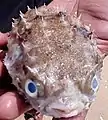| Porcupinefish Temporal range: | |
|---|---|
 | |
| Diodon nicthemerus | |
| Scientific classification | |
| Domain: | Eukaryota |
| Kingdom: | Animalia |
| Phylum: | Chordata |
| Class: | Actinopterygii |
| Order: | Tetraodontiformes |
| Suborder: | Tetraodontoidei |
| Family: | Diodontidae Bonaparte, 1838 |
| Genera[1] | |
|
Allomycterus | |
Porcupinefish are medium-to-large fish belonging to the family Diodontidae from the order Tetraodontiformes[2] which are also commonly called blowfish and, sometimes, balloonfish and globefish. They are sometimes collectively called pufferfish,[3] not to be confused with the morphologically similar and closely related Tetraodontidae, which are more commonly given this name.
They are found in shallow temperate and tropical seas worldwide. A few species are found much further out from shore, wherein large schools of thousands of individuals can occur.[4][5]
Characteristics
Porcupinefish are generally slow-moving.[5]
They have the ability to inflate their bodies by swallowing water or air, thereby becoming rounder. This increase in size (almost double vertically) reduces the range of potential predators to those with much bigger mouths. A second defense mechanism is provided by the sharp spines, which radiate outwards when the fish is inflated.
They have upper and lower teeth that fuse into a shape of a parrot's beak, they use this beak to eat molluscs and sea urchins.[4][6][7]
Some species are poisonous, having tetrodotoxin in their internal organs, such as the ovaries and liver. This neurotoxin is at least 1200 times more potent than cyanide. The poison is produced by several types of bacteria obtained from the fish's diet.[8] As a result of these three defenses, porcupinefish have few predators, although adults are sometimes preyed upon by sharks and orcas. Juveniles are also preyed on by Lysiosquillina maculata, tuna, and dolphins.[5]
Relationship with humans
Consumption
Porcupinefish are eaten as food fish and are an exotic delicacy in Cebu, Philippines, where they are called tagotongan. However, pufferfish can be a dangerous thing to eat since they can cause "Tetrodotoxin poisoning" which causes paralysis to certain parts of the body. Normally, this will only affect a person's health but in some cases it has led to death since there is no known antidote for this type of poisoning. This however, doesn't stop people from consuming it. In fact, the risk factor is alluring to tourists, so in certain places such as Hawaii and Tahiti, it is sold in a dried up form.
In popular culture
The porcupine fish (as Diodon antennatus) is mentioned in Charles Darwin's famous account of his trip around the world, The Voyage of the Beagle. He noted how the fish can swim quite well when inflated, though the altered buoyancy requires them to do so upside down. Darwin also mentioned hearing that a fellow naturalist, Dr. Allen of Forres, had "frequently found a Diodon, floating alive and distended, in the stomach of the shark; and that on several occasions he has known it eat its way, not only through the coats of the stomach, but through the sides of the monster".[9]
A Pufferfish named Mrs. Puff, voiced by Mary Jo Catlett, appears in the Nickelodeon animated television series Spongebob Squarepants as the title character's boating (driving) instructor.
A Pufferfish named Bloat, voiced by Brad Garrett, appears in the 2003 Disney-Pixar animated film Finding Nemo and its 2016 sequel Finding Dory.
In the Animal Crossing series, a pufferfish can be caught ingame. In Animal Crossing: New Horizons, the pufferfish model resembles a Diodon holocanthus.
Gallery
.jpg.webp) A porcupinefish in an aquarium
A porcupinefish in an aquarium A dead porcupinefish with clearly visible spines on the shore
A dead porcupinefish with clearly visible spines on the shore Preserved porcupine fish in a laboratory
Preserved porcupine fish in a laboratory A dead porcupinefish washed up on a beach
A dead porcupinefish washed up on a beach A dead porcupinefish
A dead porcupinefish- (video) Diodon nicthemerus swimming
See also
References
- ↑ Matsuura, Keiichi (January 2015). "Taxonomy and systematics of tetraodontiform fishes: a review focusing primarily on progress in the period from 1980 to 2014". Ichthyological Research. 62 (1): 72–113. doi:10.1007/s10228-014-0444-5.
- ↑ Myers, P.; Espinosa, R.; Parr, C. S.; Jones, T.; Hammond, G. S.; Dewey, T. A. (2023). "Diodontidae: Classification". Animal Diversity Web. University of Michigan Museum of Zoology. Retrieved 1 April 2023.
- ↑ Mills, D. (1993). Cooke, J. (ed.). Aquarium Fish. San Diego: Dorling Kindersley. pp. 281. ISBN 1-56458-293-0.
- 1 2 "Diodontidae - Porcupinefishes". Animal factsheets. Australian Museum. 18 June 2022. Retrieved 1 April 2023.
- 1 2 3 Matsuura, K.; Tyler, J.C. (1998). Paxton, J.R.; Eschmeyer, W.N. (eds.). Encyclopedia of Fishes. San Diego, California, USA: Academic Press. p. 231. ISBN 0-12-547665-5.
- ↑ Dudley, Gordon; Sumich, James; Cass-Dudley, Virginia L. (2011). Laboratory and Field Investigations in Marine Life. Sudbury, Massachusetts, USA: Jones & Bartlett Publishers. p. 159. ISBN 978-1-4496-0501-8.
- ↑ Ponder, Winston Frank; Lindberg, David R.; Ponder, Juliet Mary (2019). Biology and Evolution of the Mollusca. Vol. 1. Boca Raton, Florida, USA: CRC Press. ISBN 978-1-351-11565-0.
- ↑ Piper, R. (2007), Extraordinary Animals: An Encyclopedia of Curious and Unusual Animals, Greenwood Press.
- ↑ Darwin, Charles (1845). Journal of Researches Into the Natural History and Geology of the Countries Visited During the Voyage of H.M.S. Beagle Round the World: Under the Command of Capt. Fitz Roy. J. Murray. p. 14.
External links
 Media related to Diodontidae at Wikimedia Commons
Media related to Diodontidae at Wikimedia Commons Data related to Diodontidae at Wikispecies
Data related to Diodontidae at Wikispecies